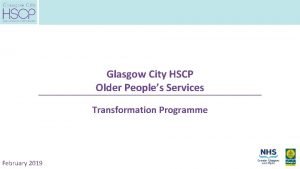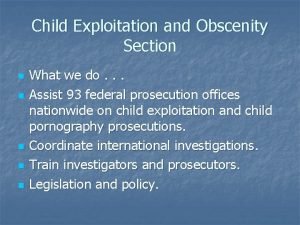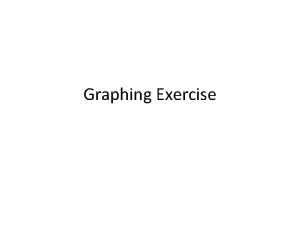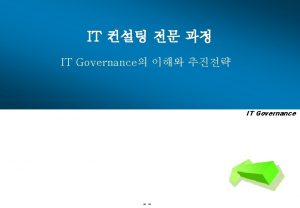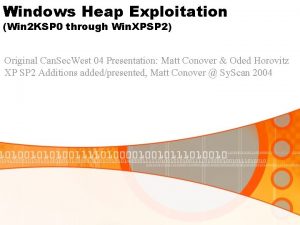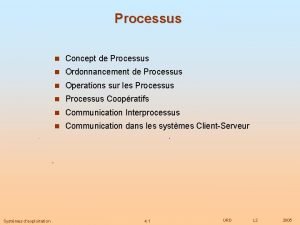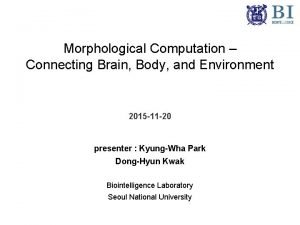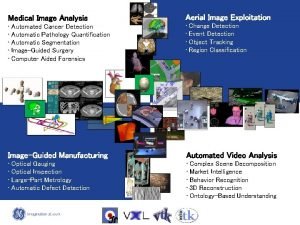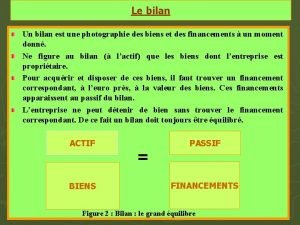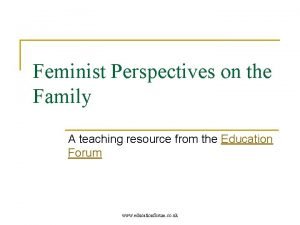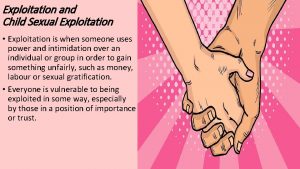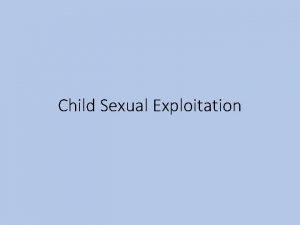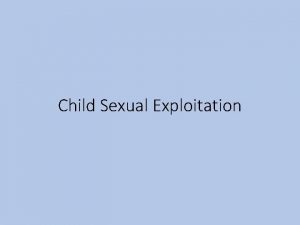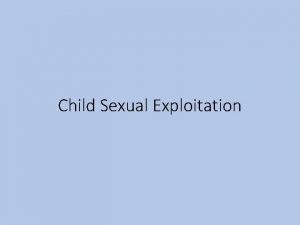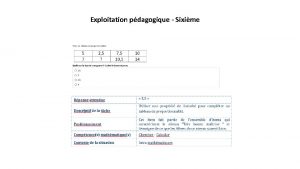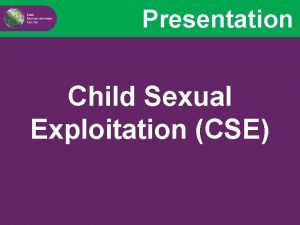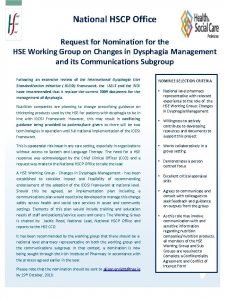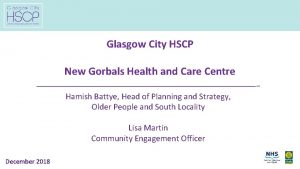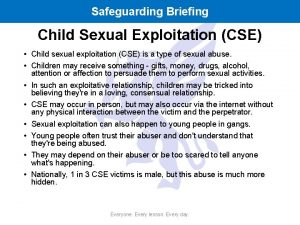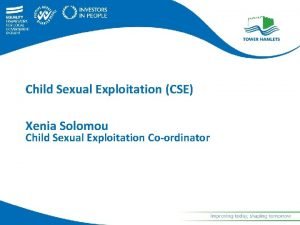HSCP Child Exploitation Training Slides Contents Introduction Types
















- Slides: 16

HSCP Child Exploitation Training Slides

Contents • Introduction • Types of Exploitation • What Makes Children Vulnerable to Exploitation? • Missing Children • The Picture in Hampshire • Identification and Support

Introduction • There are many forms of child exploitation including: sexual exploitation, criminal exploitation (including county lines) modern slavery etc. • There are clear links between child exploitation and those children who are trafficked and/or go missing and the matters cannot be dealt with in isolation. • Safeguarding is everybody’s business and all staff who have opportunities to identify children being exploited and/or those at risk of exploitation should receive training on this topic.

Child Sexual Exploitation ‘Child sexual exploitation is a form of child sexual abuse. It occurs where an individual or group takes advantage of an imbalance of power to coerce, manipulate or deceive a child or young person under the age of 18 into sexual activity (a) in exchange for something the victim needs or wants, and/or (b) for the financial advantage or increased status of the perpetrator or facilitator. The victim may have been sexually exploited even if the sexual activity appears consensual. Child sexual exploitation does not always involve physical contact; it can also occur through the use of technology’ (Definition and a guide for practitioners, local leaders and decision makers working to protect children from child sexual exploitation, HM Government, February 2017). • The guidance applies to male and female children up to the age of 18 years, irrespective of whether they are living independently, at home, with carers or in a residential setting.

Criminal Exploitation ‘Child Criminal Exploitation occurs where an individual or group takes advantage of an imbalance of power to coerce, control, manipulate or deceive a child or young person under the age of 18 into any criminal activity (a) in exchange for something the victim needs or wants, and/or (b) for the financial or other advantage of the perpetrator or facilitator and/or (c) through violence or threat of violence. The victim may have been criminally exploited even if the activity appears consensual. Child Criminal Exploitation does not always involve physical contact, it can occur through the use of technology’ (Serious Violence Strategy, the Home Office, April 2018).

County Lines ‘County lines is a term used to describe gangs and organised criminal networks involved in exporting illegal drugs into one or more importing areas [within the UK], using dedicated mobile phone lines or other form of “deal line”. They are likely to exploit children and vulnerable adults to move [and store] the drugs and money and they will often use coercion, intimidation, violence (including sexual violence) and weapons’ (Serious Violence Strategy, the Home Office, April 2018). Children who get involved in county lines come from a variety of backgrounds including those with multiple interventions from public services because of chaotic and risky home circumstances, looked after children and those from wellordered and materially comfortable families. County line owners/managers will recruit children that blend in with the drug market that the line is intended to exploit.

County Lines The national picture on county lines continues to develop but there are recorded cases of: • Children as young as 12 years old being exploited by gangs to courier drugs out of their local area. 15 -16 years is the most common age range. • Both males and females being exploited. • White British children being targeted because gangs perceive they are more likely to evade police detection. • The use of social media to make initial contact with children. • Vulnerable adults, including habitual class A drug users, being targeted so that gangs can takeover their homes (known as ‘cuckooing’).

County Lines Networks

Modern Slavery & Trafficking Modern Slavery is the term used within the UK and is defined within the Modern Slavery Act 2015. The Act categorises offences of Slavery, Servitude and Forced or Compulsory Labour and Human Trafficking. These crimes include holding a person in a position of slavery, servitude, forced or compulsory labour or facilitating their travel with the intention of exploiting them soon after. Although human trafficking often involves an international cross-border element, it is also possible to be a victim of modern slavery within your own country. It is possible to be a victim even if consent has been given to be moved. Children can be trafficked for: • • Child sexual exploitation. Benefit fraud. Forced marriage. Domestic servitude such as cleaning, childcare, cooking. Forced labour in factories or agriculture. Criminal activity such as pickpocketing, begging, transporting drugs, cannabis cultivation, selling pirated DVDs and bag theft. Serious organised crime. Debt bondage

Trafficked children Human trafficking is defined as a process that is a combination of three basic components: 1. Movement (including within the UK) - WHAT 2. Control, through harm/threat of harm or fraud - HOW 3. For the purpose of exploitation – WHY • Children cannot give consent to being exploited; therefore, the element of coercion or deception does not need to be present to prove an offence. • Any child under the age of 18 transported for exploitative reasons is considered to be a trafficking victim.

What Makes Children Vulnerable to Exploitation? Push Factors Pull Factors Missing episodes Being liked and receiving affection Looked after child (LAC) Feeling a sense of belonging History of previous abuse Opportunities to work and send money home Peer violence/gang affiliated Offered education/work opportunities Neglect and emotional abuse Meeting someone who ‘cares’ Being alienated from family/community Being taken to adult venues Being bullied/threatened Feelings of excitement about new experiences Disengaged from education Being offered a place to stay Drug/alcohol misuse within the family or child Taken to new places and feeling like they are on an adventure Offending behaviour/criminality Friendships/living with other children that have been trafficked Limited healthy friendships/peer relationships Unaccompanied Separated Receiving alcohol, drugs, money, gifts Alone in the UK Separated from family who are not in the UK

Missing Children The College of Policing definition: • ‘Anyone whose whereabouts cannot be established will be considered missing until located and their wellbeing or otherwise confirmed. Categories of risk will be no apparent risk, low, medium, or high’. The Department for Education definitions: • Missing Child: a child reported as missing to the police by their family or carers. • Missing from care: a looked after child who is not at their placement or the place they are expected to be (e. g. school) and their whereabouts is not known.

Missing Children • Research estimates that 100, 000 children runaway each year including 10, 000 reported as missing from care. • Children who go missing from home or care at risk of being targeted for involvement in gangs, trafficking, criminalisation, sexual exploitation and violence. • Recognising the risk at the time a child is reported as missing, and offering a child appropriate support on return, may prevent exploitation. • Children go missing for a number of reasons. A range of ‘push’ and ‘pull’ factors may be present.

Missing Children Push Factors Pull Factors Arguments and conflict - usually involving family or friends but sometimes school staff Wanting to be with family/friends Conflict within the home or placement The attraction of staying out with peers, boyfriends or girlfriends Poor family relationships - or the introduction of a step-parent that can trigger lots of mixed emotions Running to be near friends or family, especially when a young person is in care and there are problems with contact arrangements Physical and/or emotional abuse The attraction of risky behaviours such as substance or alcohol misuse, offending and anti -social behaviour Being bullied/abused Wanting freedom and independence Being unhappy/not being listened to Being made to feel special by grooming for potential exploitation or child trafficking Boundary and control issues - a lack of parental control or being beyond parental control may contribute to risk taking behaviours, particularly during adolescence • Peer pressure • Friendships/living with other children that have been trafficked • For those who have been tracked into the UK there will be pressure to make contact with their trafficker

The Picture in Hampshire • In line with a South East Regional Organised Crime Unit (SEROCU) study in 2017, individuals rather than gangs continue to pose the biggest threat in the Hampshire Local Authority area (2018). • Victims are mostly white British females aged around 15 years; offenders are commonly white British males aged around 18 years (2018). • The internet remains a key thematic threat and helps perpetrators exploit children. • There are cross-overs between all forms of exploitation. Missing episodes, trafficking and exploitation are interlinked and affect both boys and girls from any background. • The impact of exploitation on boys is not always recognised in the same way as girls.

Identification and Support If you are concerned that a child is being exploited, or at risk of being exploited, contact Children’s Services. If you suspect that a crime has been committed, a contact to the police must be made via 101. • • Hampshire County Council Children’s Services: 0300 555 1384 Isle of Wight Council Children’s Services: 01983 814 545 Portsmouth City Council Children’s Services: 0845 671 0271 Southampton City Council Children’s Services: 02380 833 336 If you have obtained non-urgent information/intelligence linked to the exploitation of children (e. g. locations of concern, potential perpetrators), the police Community Partnership Information (CPI) form must be submitted. This form gives professionals a safe and direct way to share this information with the police. Each Local Safeguarding Children Partnership covering Hampshire, Southampton, Portsmouth and Isle of Wight will have a range of tools to support you in identifying exploitation and reporting your concerns.
 A small child slides down the four frictionless slides
A small child slides down the four frictionless slides John pushes hector on a plastic toboggan
John pushes hector on a plastic toboggan Hscp glasgow
Hscp glasgow History of child beauty pageants
History of child beauty pageants Child exploitation and obscenity section
Child exploitation and obscenity section Definition of child exploitation uk
Definition of child exploitation uk Clovis adults school program
Clovis adults school program Tvmdc compass correction
Tvmdc compass correction A child climbs up a slide and then slides down graph
A child climbs up a slide and then slides down graph Contents introduction
Contents introduction Windows heap exploitation
Windows heap exploitation Système d exploitation
Système d exploitation Exploitation
Exploitation Image analysis and exploitation
Image analysis and exploitation Bilan fonctionnel exemple
Bilan fonctionnel exemple Exploitation plan example
Exploitation plan example Exploitation
Exploitation


